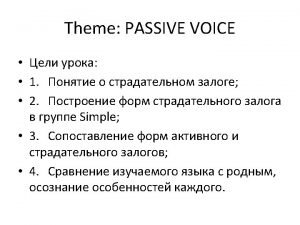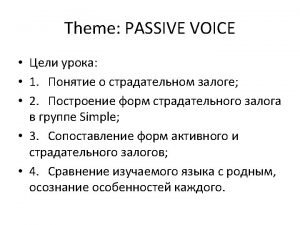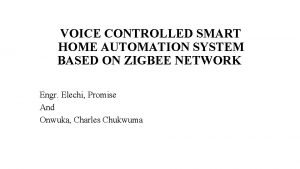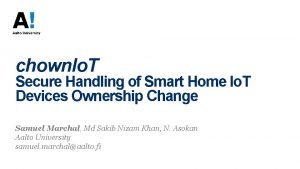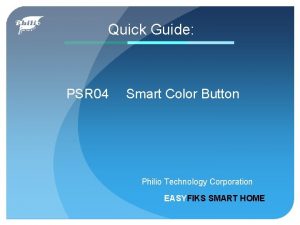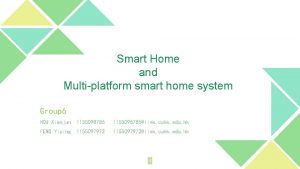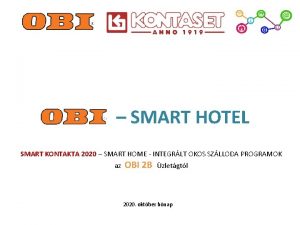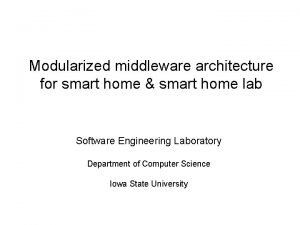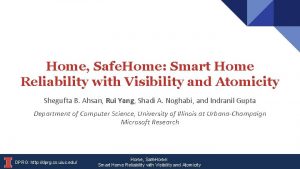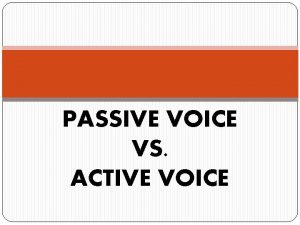Design and evaluation of a Smart home voice








![3. Design and evaluation of voice interface Development of Sweet-Home system[1] 3. Design and evaluation of voice interface Development of Sweet-Home system[1]](https://slidetodoc.com/presentation_image_h/099e902cc5366170911e1c584bdec67c/image-9.jpg)

![3. Design and evaluation of voice interface Summary of the participants’ characteristics[1] 3. Design and evaluation of voice interface Summary of the participants’ characteristics[1]](https://slidetodoc.com/presentation_image_h/099e902cc5366170911e1c584bdec67c/image-11.jpg)









![References [1] Portet F, Vacher M, Golanski C, Roux C, Meillon B(2013). Design and References [1] Portet F, Vacher M, Golanski C, Roux C, Meillon B(2013). Design and](https://slidetodoc.com/presentation_image_h/099e902cc5366170911e1c584bdec67c/image-21.jpg)
- Slides: 21

Design and evaluation of a Smart home voice interface for the elderly: acceptability and objection aspects Xingtian Dong xid 31@pitt. edu

v. Main paper Portet F, Vacher M, Golanski C, Roux C, Meillon B(2013). Design and evaluation of a smart home voice interface for the elderly: acceptability and objection aspects. Pers Ubiquit Comput, 17: 127 -144 v. Sub paper Vacher M, Istrate D, Portet F, Joubert T, Chevalier T, Smidtas S, Meillon B, Lecouteux B, Sehili M, Chahuara P, Mniard S (2011) The sweet-home project: audio technology in smart homes to improve well-being and reliance. In: 33 rd Annual international conference of the IEEE engineering in medicine and biology society (EMBC’ 11), p. 4

Contents 1. 2. 3. 4. Background Introduction to Sweet-Home Project Design and evaluation of voice interface Overview and discussion

1. Background According to the World Health Organization (WHO), the number of people aged 60 and over will reach 2 billion by 2050[3]!!

1. Background Why voice interface? • It is physically intangible • It doesn’t force the user to be physically at a particular place to operate • It provides interaction using natural language • It can capture sounds of everyday life[2]

2. Introduction to Sweet-Home Project The SWEET-HOME project is a French national supported research project aiming at designing a new smart home system based on audio technology focusing on three main aspects: • to provide assistance via natural man-machine interaction • to ease social inclusion • to provide security reassurance by detecting situations of distress[2]

2. Introduction to Sweet-Home Project The KNX bus system (Ko. Nne. X), a worldwide ISO standard (ISO/IEC 14543) for home and building control has been chosen as main communication bus.

2. Introduction to Sweet-Home Project Smart home corpus acquisition Sound classification 14 sound classes were used: breathlessness, door-slamming, electrical shaver, female cry, female scream, hair-dryer, paper, glass breaking, laugh, sneeze, cough, dishes and yawn A GMM (Gaussian Mixture Models) based classifier with an optimum number of Gaussians determined using the ANASON software developed at ESIGETEL and an SVM (Support Vector Machine) based approach. The GMM led to higher results than the SVM one (92% of correct classifications vs. 87%). [2]
![3 Design and evaluation of voice interface Development of SweetHome system1 3. Design and evaluation of voice interface Development of Sweet-Home system[1]](https://slidetodoc.com/presentation_image_h/099e902cc5366170911e1c584bdec67c/image-9.jpg)
3. Design and evaluation of voice interface Development of Sweet-Home system[1]

3. Design and evaluation of voice interface Wizard of Oz experiment design The participants consisted of 18 persons from the Grenoble area. They were divided up into three groups: elderly (n = 8); relatives (n = 7)—composed of mature children, grandchildren or friends—; and caregivers (n = 3). The mean age of the elderly group was 79. 0 (SD = 6. 0), and 5 out of 8 were women. These persons were single and perfectly autonomous. The frequency of visit by their relative was from once a week to everyday. The majority did not have a computer (except one) and did not consult Internet often. Professions were diverse: dressmaker, engineer, teacher, accountant, secretary and farmer. The mean age of the relative group was 41. 0 (SD = 19. 5), and 5 out of 7 were women. Their relationship with their elder partner varies but they were chiefly grandchildren (4/7)[1].
![3 Design and evaluation of voice interface Summary of the participants characteristics1 3. Design and evaluation of voice interface Summary of the participants’ characteristics[1]](https://slidetodoc.com/presentation_image_h/099e902cc5366170911e1c584bdec67c/image-11.jpg)
3. Design and evaluation of voice interface Summary of the participants’ characteristics[1]

3. Design and evaluation of voice interface The goal of the study The aim of this study was to assess the acceptability of the SWEETHOME system. But, there is no standard definition about the user acceptability in this domain [4]. Users can reject a new technology because it is too complex, too intrusive, not natural, does not fit their education or religion, does not meet their needs, etc. Four scenarios were studied: • Voice command aspect of the Sweet-Home project • Communication with the outside. • System interruption. • Shared electronic calendar

3. Design and evaluation of voice interface Interaction with the smart home using speech The first part of the scenario was to make the seniors ask the home to activate a domestic device using their voice, without giving them any recommendation about how to do it. Half of the seniors found it natural. In contrast, almost all the relatives(6/7) found the voice interaction natural. In the second part, seniors were asked to command elements of the home using dedicated physical device. Most of the elderly people(6/8) said they prefer to speak to the home. Similarly, almost all relatives found suitable(2/7) or very suitable(4/7) to use the voice control system. [1]

3. Design and evaluation of voice interface Communication with the exterior In the first part, each senior was left alone watching TV when suddenly their relative started a conversation with them and appeared on the screen. All seniors found this good(6/8) or very good(2/8). Similarly, all relatives found this good(5/7) or very good(2/7). Drawback: This kind of communication may be intrusive especially when the caller is not a close relative and may violate privacy. In the second part, people were asked if they would like to answer the phone anywhere in the house. Almost all them (7/8) would find it interesting. [1]

3. Design and evaluation of voice interface Alerts generated by the system In this scenario, the aim was to observe how people react when the system interrupts them to warn them about security problems, appointments or birthdays. Regarding security, all seniors found good or very good that the system signals security issues. Regarding the appointment reminder, almost all seniors(6/8) did not like being informed by the system when they are having a conversation with interviewer. Regarding the suddenness of the interruption, almost all(7/8) seniors prefer that the system emits a short sound before it speaks. 5 of them said the sound must be different according to the alert. [1]

3. Design and evaluation of voice interface Shared calendar In this scenario, the aim was to investigate what the older people would think about an agenda that would be visible on the television. Almost all the elderly thought that the calendar would not be helpful(2/8) or not helpful at all(5/8). Relatives also found this type of agenda unhelpful(2/7) or not helpful at all (4/7) They thought that the system should warn the elderly of a future appointment using a vocal message. [1]

4. Overview and discussion Biases of the study The participants all came from the same area of France and the sample is quite small. The experiment was not done in real in-situ conditions and participants did not really ‘live’ with the system. This experiment was done in co-discovery, thus seniors were always accompanied by a relative. The seniors often rely on a close relative to make decisions when concerning their autonomy. The relatives tends to increase with the degree of dependence of the senior. But the experiment has clearly emphasized they two categories of people. [1]

4. Overview and discussion Main feature appreciated by the participants Seniors preferred mostly the voice command for the blinds and light, the system interventions about safety issues and video-conferencing. Relatives mostly liked the voice command for the blinds and light, the system interventions about safety issues and video-conferencing. The voice command is the preferred feature of the system overall along with the interruptions about security issues. Key word form commands is highly accepted. [1]

4. Overview and discussion Main fears provoked by the system The main fear of the elderly and relatives is the system failure. If the system take over everything, the elderly may highly dependent on the system. So the failure might be critical to the elderly. Two of the elderly considered implementing microphones at home is a problem. They thought they don’t have freedom any more. But in contrast, All the seniors would refuse video cameras at home. Security is the main interest. If the system can be controlled by other people through phone call or just near the house. Privacy must be preserved. Some elderly were afraid of being recorded. Another potential infringement on privacy is the feeling of intrusion when the system suddenly interrupts the person to remind them of an appointment.

Any questions?
![References 1 Portet F Vacher M Golanski C Roux C Meillon B2013 Design and References [1] Portet F, Vacher M, Golanski C, Roux C, Meillon B(2013). Design and](https://slidetodoc.com/presentation_image_h/099e902cc5366170911e1c584bdec67c/image-21.jpg)
References [1] Portet F, Vacher M, Golanski C, Roux C, Meillon B(2013). Design and evaluation of a smart home voice interface for the elderly: acceptability and objection aspects. Pers Ubiquit Comput, 17: 127 -144 https: //dl. acm. org/citation. cfm? id=2424740 [2] Vacher M, Istrate D, Portet F, Joubert T, Chevalier T, Smidtas S, Meillon B, Lecouteux B, Sehili M, Chahuara P, Mniard S (2011) The sweet-home project: audio technology in smart homes to improve well-being and reliance. In: 33 rd Annual international conference of the IEEE engineering in medicine and biology society (EMBC’ 11), p. 4 http: //www-clips. imag. fr/geod/User/francois. portet/publications/embc_getalp_esigetel. pdf [3] World Health Organization web page http: //www. who. int/mediacentre/factsheets/fs 404/en/ [4] Augusto JC (2009) Past, present and future of ambient intelligence and smart environments. In: ICAART, pp 11– 18
 Passive voice sentences structure
Passive voice sentences structure Passive voice tenses chart
Passive voice tenses chart Voice in grammar
Voice in grammar Book smarts vs street smarts
Book smarts vs street smarts One smart man he felt smart
One smart man he felt smart It's not how smart you are
It's not how smart you are Ways to pay future smart answers
Ways to pay future smart answers Eight types of intelligence
Eight types of intelligence What is the next letter? a z b y c x d
What is the next letter? a z b y c x d Street smart vs book smart quotes
Street smart vs book smart quotes One smart man he felt smart
One smart man he felt smart Smart home conclusion
Smart home conclusion Conclusion of smart grid
Conclusion of smart grid Smart home device
Smart home device Psc 01
Psc 01 Vietablet
Vietablet Passive to active converter
Passive to active converter Passive voice past tense
Passive voice past tense Passive cvičenia
Passive cvičenia Apa arti home care
Apa arti home care Perbedaan home care dan home visit
Perbedaan home care dan home visit Homes for sale in roebuck sc
Homes for sale in roebuck sc




